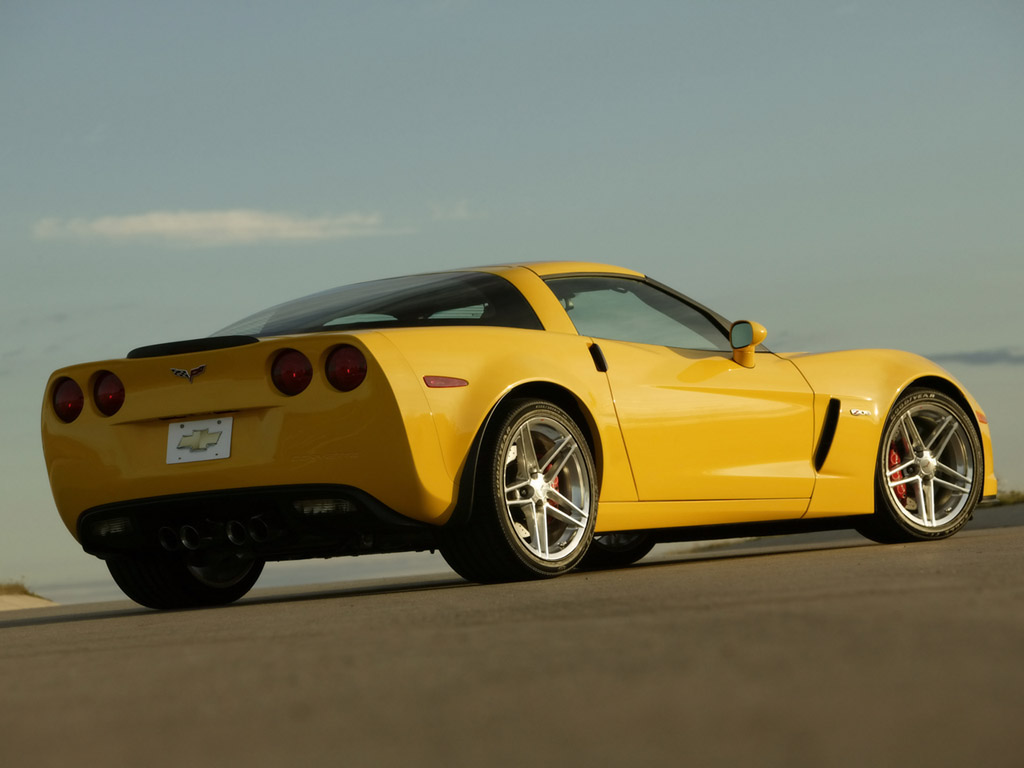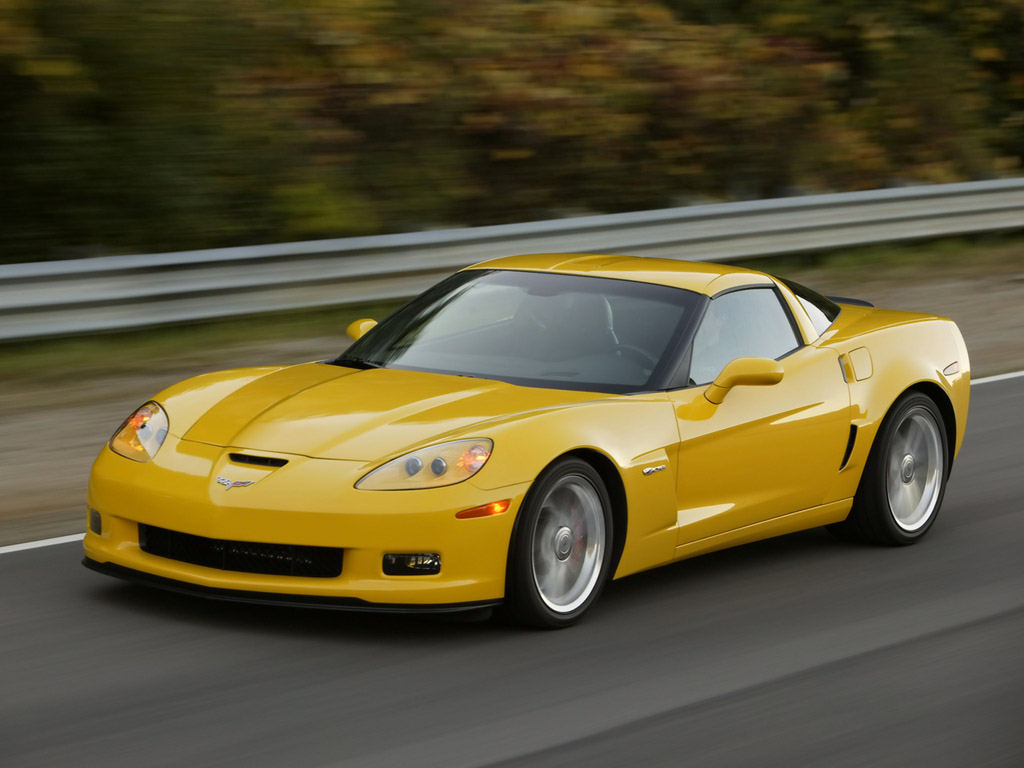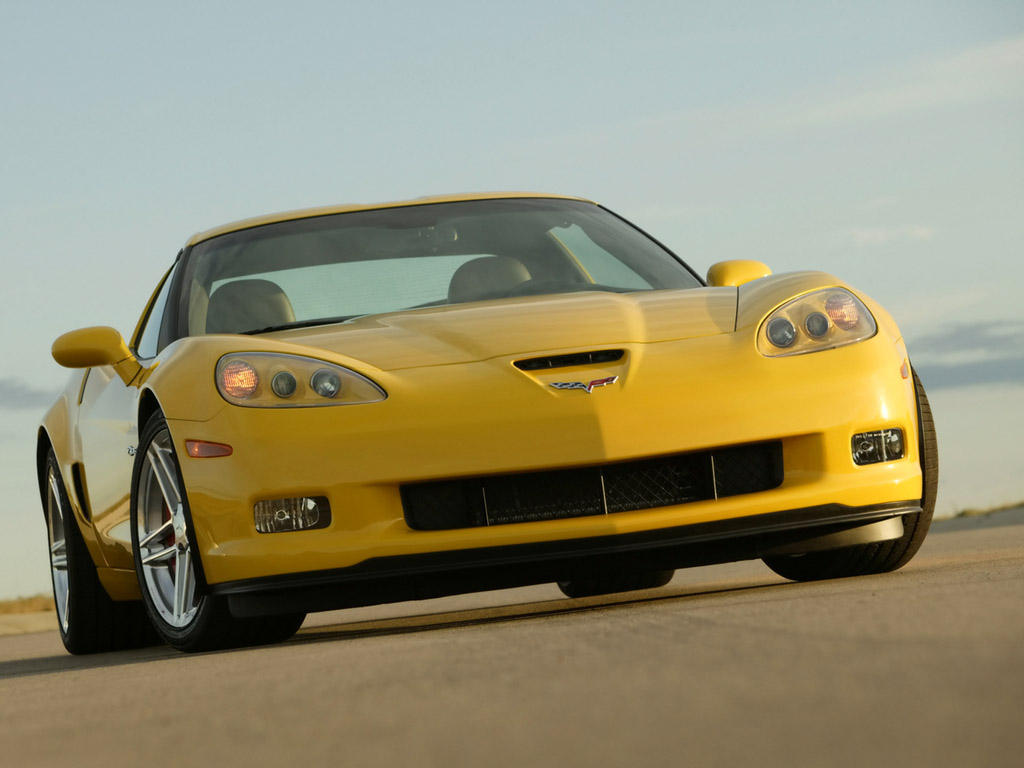2006 Chevrolet Corvette Z06
|
Price |
-- |
Production |
-- | ||
|
Engine |
427 cu in (7 liter) LS7 V8 |
Weight |
3130 lbs | ||
|
Aspiration |
natural |
Torque |
475 @ 4800 rpm | ||
|
HP |
500 hp @ 6200 rpm |
HP/Weight |
6.3 lbs per hp | ||
|
HP/Liter |
71.4 hp per liter |
1/4 mile |
less than 12 seconds | ||
|
0-62 mph |
less than 4 seconds |
Top Speed |
over 190 mph |
(from GM Press
Release) By winning every race in the 2004 season, the
Corvette C5-R racing team wrapped up the most successful era in
Corvette’s 50-year racing history. In its five years, the C5-R
racing program took 35 victories in 55 races, four American Le Mans
Series championships and three double victories at the 24 Hours of
Le Mans .
The Z06 sparked the second half of the C5’s life span with a
Corvette model for the extreme performance enthusiast. Now, Team
Corvette combines the numerous attributes of the sixth-generation
Corvette with the technology and winning determination from the C5-R
program to take the new Z06 to the next level in total performance.
Chevrolet introduced the 2006 Corvette Z06 at the North American
International Auto Show. It is the fastest, most powerful car ever
offered by Chevrolet and General Motors. It is comprised of an
unprecedented level of capability and technology, making it one of
the greatest performance values on the market. And with an
unmistakably muscular appearance, the ’06 Z06 has a visual attitude
that always looks ready to demonstrate Corvette’s winning attitude
to any challenger around the globe.
“The new Z06 is the dividend from competing so successfully in
endurance racing,” said Dave Hill, Corvette’s chief engineer. “It
combines the strong attributes of the new, sixth-generation Corvette
with the spirit, technology and know-how from the race program to
form an American supercar with outstanding credentials.”
The new Z06 achieves 500 horsepower in an approximately 3130-pound
(1419.7 kg) package and is expected to deliver 0-60 performance of
less than 4 seconds, eclipse the quarter-mile in less than 12
seconds and deliver a top speed of more than 190 mph on a race
track.
The links between racing and the production Z06 are both direct and
indirect, as the vehicle was developed in conjunction with the
forthcoming C6-R racecar, but they boil down to the application of
lessons that could only have been learned after countless laps of
endurance racing – everything from suspension geometry to
aerodynamics. What the engineers developed was a totally unique
vehicle that has its own powertrain, body structure and chassis
system which are distinct from other Corvette models.
Previous Z06 models, from the original 1963 model to the 2001-04
editions, incorporated suspension and/or engine upgrades that
complemented existing Corvette systems. Not surprisingly, the specs
for the ’06 read like the blueprint of a champion. They include:
LS7 7.0-liter/427-cubic-inch Gen IV V-8 with lightweight reciprocating components
500 horsepower (373 kw) at 6200 rpm
475 lb.-ft. of torque (657 Nm) at 4800 rpm
7000 rpm redline
Titanium connecting rods and intake valves
Dry-sump engine lubrication system
Engine hand-built at GM’s new Performance Build Center
Aluminum body structure with one-piece hydroformed perimeter rails frame and magnesium front cradle
Fixed roof design optimizes body rigidity and aerodynamics
Carbon-fiber composite front fenders and front wheelhouses
Unique front fascia incorporating a larger grille, cold-air scoop and lower air splitter
Wide-body rear fenders and a unique rear spoiler incorporated with the CHMSL
Huge 14-inch (355-mm) cross-drilled front disc brakes with six-piston calipers and 13.4-inch (340-mm) cross-drilled rear rotors with four-piston calipers
18 x 9.5-inch front wheels with 275/35ZR18 tires and 19 x 12-inch rear wheels with 325/30ZR19 tires
3-inch-diameter exhaust with bi-mode mufflers and larger polished stainless steel tips
Engine, transmission and differential oil coolers; and steering cooler
Rear-mounted battery to improve weight distribution
Unique interior features including revised gauge cluster and lightweight two-tone seats with more aggressive bolsters
Curb weight of 3130 pounds / 1419.7 kg (estimated)
3 inches (76.2 mm) wider than other Corvette models
Vehicle developed simultaneously with C6-R racecar.
The features above are merely the highline points of the comprehensively designed Z06. What follows is a closer look at the vehicle’s unique attributes.
LS7 engine
The all-new LS7 of the
’06 Z06 reintroduces the 427-cubic-inch engine to the Corvette
lineup. Unlike the previous 427 engine, which was a big-block
design, the new 7.0-liter LS7 is a small-block V-8 – the
largest-displacement small-block ever produced by GM and a tribute
to its 50 years as a performance icon.
With 500 horsepower and 475 lb.-ft. of torque, it also is the most
powerful passenger car engine ever produced by Chevrolet and GM. The
LS7 is easily identified under the hood by red engine covers with
black lettering.
The LS7 shares the same basic Gen IV V-8 architecture as the
Corvette’s 6.0-liter LS2, but the LS7 uses a different cylinder
block casting with pressed-in steel cylinder liners to accommodate
the engine’s wide, 104.8-mm-wide cylinder bores; the LS2 has
101.6-mm bores. And when compared to the LS2, the LS7 also has a
different front cover, oil pan, exhaust manifolds and cylinder
heads.
Internally, the LS7’s reciprocating components make use of
racing-derived lightweight technology, including titanium connecting
rods and intake valves, to help boost horsepower and rpm capability.
The rpm fuel shut-off limit is 7000 rpm.
The LS7’s specifications include:
Unique cylinder block casting with large, 104.8-mm bores and pressed-in cylinder liners
Forged steel main bearing caps
Forged steel crankshaft
Titanium connecting rods with 101.6-mm stroke
Forged aluminum flat-top pistons
11.0:1 compression
Dry-sump oiling system
Camshaft with .591-inch lift
Racing-derived CNC-ported aluminum cylinder heads with titanium intake valves and sodium-filled exhaust valves
Titanium pushrods and valve springs
Low-restriction air intake system
Hydroformed exhaust headers with unique “quad flow” collector flanges.
“In many ways, the LS7
is a racing engine in a street car,” said Dave Muscaro, assistant
chief engineer of small-block V-8 for passenger cars. “We’ve taken
much of what we’ve learned over the years from the 7.0-liter C5-R
racing program and instilled it here. There really has been nothing
else like it offered in a GM production vehicle.”
One of the clearest examples of the LS7’s race-bred technology is
its use of titanium connecting rods. They weigh just 480 grams
apiece, almost 30 percent less than the rods in the LS2 V-8. Besides
being lightweight, which enhances high-rpm performance and rpm
range, titanium makes the rods extremely durable.
The LS7’s CNC-ported aluminum cylinder heads are all-new and
designed to meet the high airflow demands of the engine’s 7.0-liter
displacement, as it ingests approximately 100 cubic feet more air
per minute than the Corvette’s 6.0-liter LS2 V-8 – an 18-percent
increase in airflow. Consequently, a hydraulic roller camshaft with
.591/.591-inch valve lift is used to allow plenty of air to
circulate in and out of the engine.
To ensure optimal, uninterrupted airflow, the LS7’s heads have
straight, tunnel-like intake runners. Very large by
production-vehicle standards – even racing standards – they are
designed to maintain fast airflow velocity, providing excellent
torque at low rpm and exhilarating horsepower at high rpm. The heads
feature 70-cc combustion chambers which are fed by huge,
56-mm-diameter titanium intake valves. The lightweight titanium
valves weigh 21grams less than the stainless steel valves used in
the LS2, despite the valve head having 22 percent more area. They
are complemented by 41-mm sodium-filled exhaust valves, vs. 39.4-mm
valves in the LS2. To accommodate the large valve face diameters,
the heads’ valve seats are siamesed; and, taken from experience with
the engines of C5-R racecars, the LS7’s valve angles are held at 12
degrees – versus 15 degrees for the LS2 – to enhance airflow through
the ports.
All LS7 engines are assembled by hand at GM Powertrain’s new
Performance Build Center in Wixom , Mich. The exacting standards to
which they are built include deck-plate honing of the cylinders – a
procedure normally associated with the building of racing engines
and almost unheard of in a production-vehicle engine.
Dry sump oiling system
The LS7 has a dry-sump
oiling system designed to keep the engine fully lubricated during
the high cornering loads the Corvette Z06 is capable of producing.
An engine compartment-mounted 8-quart reservoir delivers oil at a
constant pressure to a conventional-style oil pump pick-up at the
bottom of the engine. The pressurized oil feed keeps the oil pick-up
continually immersed in oil at cornering loads exceeding 1 g.
Oil circulates through the engine and down to the oil pan, where it
is sent back to the reservoir via a scavenge pump. The
large-capacity reservoir, combined with a high efficiency air-to-oil
cooler, provides necessary engine oil cooling under the demands of
the engine’s power output. With the dry-sump system, oil is added to
the engine via the reservoir tank – which includes the oil level
dipstick.
The LS7’s dry-sump system was developed and tested on racetracks in
the United States and Europe , including Germany ’s famed
Nürburgring. And while common in racing cars, the Corvette Z06 is
one of just a handful of production vehicles – and the only
production Corvette – to ever incorporate such a high-performance
oiling system.
Drivetrain
The Corvette Z06’s
powertrain and drivetrain systems are matched to the LS7’s
performance capability. The light, four-into-one headers discharge
in to new, close-coupled catalytic converters and through to new
“bi-modal” mufflers. The mufflers each feature a vacuum-actuated
outlet valve, which controls exhaust noise during low-load operation
but opens for maximum power.
At the rear of the LS7 engine, a single-mass flywheel and
lightweight, high-capacity clutch channel torque to the rear
transaxle. The six-speed manual transmission has been strengthened
to handle the LS7’s increased torque load. The transmission includes
a pump which sends transmission fluid to the front radiator for
cooling. Upon its return, the fluid removes additional heat from the
differential lube before returning to the transmission.
The M6 transmission connects to a limited-slip differential, with
enlarged ring and pinion gears. Stronger axle half-shafts with
tougher universal joints transmit power to the rear wheels.
Body structure
The Z06 has a unique
aluminum body structure for optimum stiffness and light weight for
the fixed-roof bodystyle. Perimeter rails are one-piece hydroformed
members featuring cast suspension nodes, which replace many welded
steel components on other Corvette models. Other castings, stampings
and extrusions are combined into the innovative structure with
state-of-the-art manufacturing technologies.
Advanced structural composites featuring carbon fiber are bonded to
the aluminum structure. The wider front wheelhouses, for example,
are carbon composites and the passenger compartment floors combine
carbon-fiber skins with an ultra-lightweight balsa wood core.
Chassis system
The 2006 Corvette Z06
has a new magnesium cradle that serves as the attachment point for
the engine and some front suspension components. Magnesium is
lighter than aluminum yet incredibly strong. The magnesium cradle
helps improve the front-to-rear weight distribution, as do
carbon-fiber front fenders and wheelhouses. Engineers also moved the
battery from underhood to a position in the rear cargo area, behind
one of the rear wheels.
“This is an instance where the street car uses more advanced
material than the racecar,” said Hill. “We’re constrained by rules
to run the steel frame in the racecars, but we stretched to bring
even more performance technology to the street for out customers.”
The mass reductions are offset by some added performance enablers,
including dry-sump lubrication, 3-inch (76.2-mm) exhaust with outlet
valves, larger wheels and tires, more power brake and stiffer roll
stabilizers.
Suspension, brakes, wheels and tires
The Z06 retains the
106-inch (2686-mm) wheelbase of other Corvette models, as well as
the short-long arm suspension and transverse leaf spring design, but
it rides on all-new wheels, tires, brakes, as well as its own rear
spring and roll stabilizer.
The firmer suspension works harmoniously with large 18 x 9.5-inch
cast-spun aluminum wheels and 275/35ZR18 tires in the front, and 19
x 12-inch cast-spun aluminum wheels with 325/30ZR19 tires in the
rear – the largest wheel-and-tire combination ever offered on a
Corvette. The tires use the latest extended-mobility technology from
Goodyear to provide a satisfactory ride, but still allow the vehicle
to achieve lateral acceleration of more than 1 g. The
extended-mobility tires eliminate the need – and weight – for a
spare tire and jack or inflator kit, and reduce the chance of a
sudden loss of handling capability.
“The Z06 enables the driver to turn excellent track lap times, but
it also is quick to learn and is very forgiving for its performance
level,” said Hill. “We tested its capability around the world to
ensure it will feel at home on any road or race track.”
Complementing the suspension system and large rolling stock is an
equally capable four-wheel disc brake system, consisting of 14-inch
(355-mm) vented and cross-drilled front rotors and 13.4-inch
(340-mm) vented and cross-drilled rear rotors. For comparison, the
’05 Corvette has 12.8-inch (325-mm) front and 12-inch (305-mm) rear
rotors, while the ’05 Corvette with the Z51 has 13.4-inch (340-mm)
and 13-inch (330-mm) rotors.
The front rotors are acted upon by huge, red-painted six-piston
calipers that use six individual brake pads. Individual brake pads
are used because they deliver more equalized wear compared to what
would otherwise be a pair of very long single-piece pads. For the
rear brakes, four-piston calipers with four individual brake pads
are used. A Delphi four-channel ABS system is used, as is a very
competent active handling system – complete with a Competitive
Driving mode.
The large brakes bring an excellent level of stopping capability
with the Z06, and with their four-wheel brake cooling, they provide
excellent fade resistance and lining life during track duties.
Distinct design
The new Z06 has an unmistakable and aggressive appearance, with design cues that include:
A wide front fascia with a large, forward-facing grille opening, a splitter along the bottom and
“Gurney lips” along the sides to provide aerodynamic downforce
A cold air scoop in front of the hood that integrates an air inlet system for the engine
The trailing edge of the front wheel opening is radiused to achieve improved drag, but protects the body finish with a tough molding, and a large air extractor is located behind the wheel
A fixed-roof bodystyle optimizes body rigidity and aerodynamics
Wider rear fenders with flares cover the massive rear tires and a brake cooling scoop in front of the wheels visually balances the fender extractor
A tall rear spoiler houses the CHMSL on the top of the rear fascia
10-spoke wheels
Four larger stainless steel exhaust outlets
New-design Z06 badging on the front fenders
While the function of the Z06’s design is to move air efficiently over the body and reduce lift, the net effect is a car that looks like a weight lifter whose muscles are straining the seams of his shirt.
“The Z06 has been
sculpted very carefully, with every element in its design serving a
performance function,” said Hill. “It also has a purposeful,
menacing resemblance to the C6-R.”
The aerodynamics of the Z06’s exterior were shaped by the
experiences of the Corvette racing program, where high-speed
stability and cornering capability are paramount. And while the
racecars use large rear wings, the Z06’s elevated spoiler provides
sufficient downforce to balance the road-worthy front splitter
without adversely affecting aerodynamic drag. The Z06’s Cd is .31.
Uncompromising amenities
For all its
race-inspired functionality, the Z06 is designed to be a daily
drivable high-performance vehicle. To that end, comfort and
convenience are held to a very high standard. HID lighting, fog
lamps, leather seating, dual-zone air conditioning, cabin air
filtration and Head-Up Display (HUD) with track mode and g-meter are
standard.
The Z06 also has a revised gauge cluster that displays the Z06 logo
on the 7000-redline tachometer and has a new readout on the oil
pressure gauge to reflect the higher standard pressure of the
dry-sump oiling system. And, like other 2006 Corvettes, the Z06 has
a new, smaller-diameter three-spoke steering wheel that provides a
more agile, performance-oriented feel. The seats feature two-tone
leathering surfaces, with Z06-logo embroidery and contrasting
stitching.
Z06 options include a Bose audio system with an in-dash six-CD
changer, polished wheels, a telescoping steering wheel, heated
seats, side air bags, a navigation system with GPS, Homelink and XM
Satellite Radio.
But for all its comfort, engineers did sacrifice a few components in
the quest for lower weight and higher performance:
Side bolsters are fixed and more aggressive to better hold the driver when cornering and they weigh less than standard-model seats
Passenger seat features manual controls, saving the weight of a power-adjust motor
Acoustic package revised to reduce weight and allow more aural feedback of the powertrain.
Production of the 2006 Corvette Z06 will begin in the second half of 2005 at the Bowling Green , Ky. , Assembly Plant.



